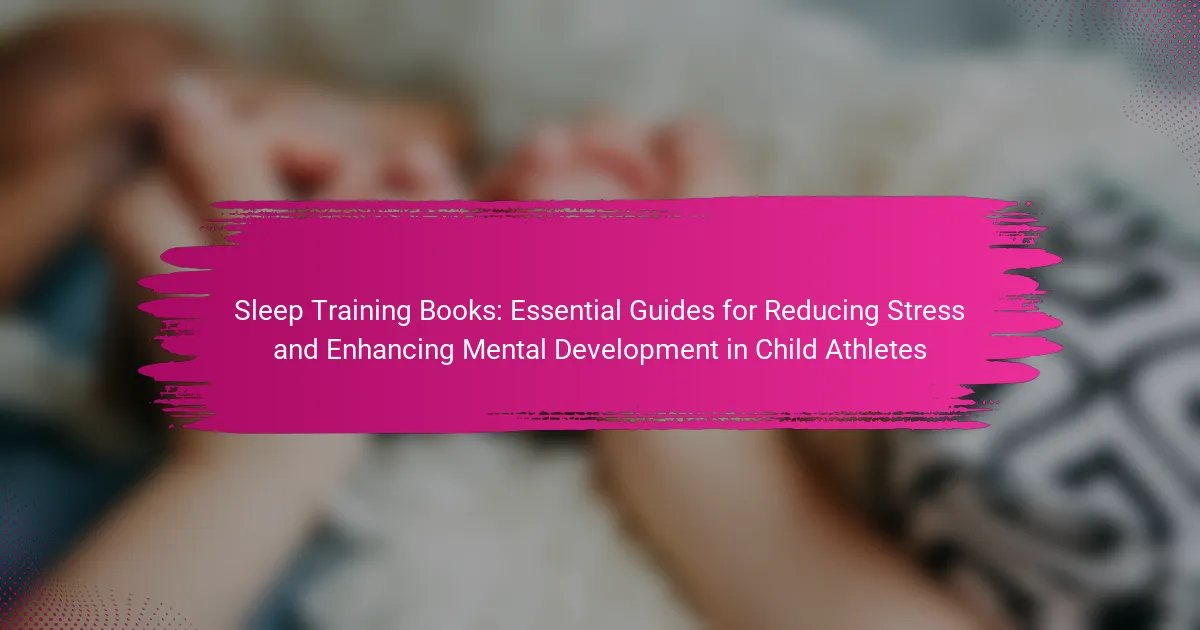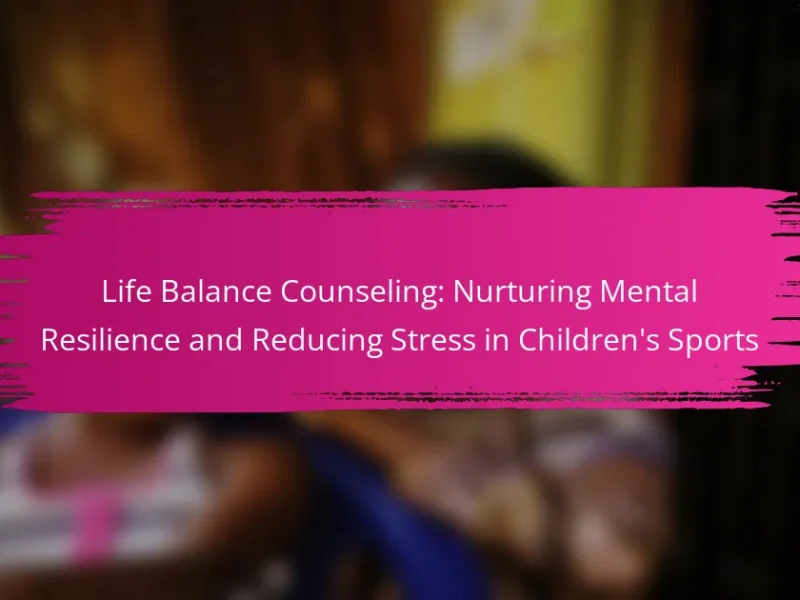Sleep training books are essential for reducing stress and enhancing mental development in child athletes. They provide structured guidance on establishing healthy sleep habits, which are crucial for athletic performance. These resources offer evidence-based strategies, practical tips for parents, and insights into the science of sleep. By prioritising rest, families can support their child’s overall well-being and competitive success.

What role do sleep training books play in reducing stress for child athletes?
Sleep training books play a crucial role in reducing stress for child athletes by providing structured guidance on establishing healthy sleep habits. These resources educate parents and coaches on the importance of sleep for mental development and athletic performance. Enhanced sleep quality leads to improved focus, emotional regulation, and resilience in competitive environments. Research indicates that adequate sleep can significantly lower anxiety levels in young athletes, allowing them to perform at their best. By incorporating strategies from sleep training books, families can foster a supportive environment that prioritises rest and recovery, ultimately benefiting the child’s overall well-being and athletic success.
How do these books address mental development in young sports participants?
Sleep training books enhance mental development in young sports participants by promoting better sleep quality, which directly impacts cognitive function and emotional resilience. These guides provide strategies for establishing healthy sleep routines, reducing anxiety, and improving focus during athletic performance. Research indicates that adequate sleep can lead to improved decision-making skills and better stress management, crucial for young athletes. Additionally, these books often include techniques for relaxation and mindfulness, further supporting mental growth and overall well-being in competitive environments.
What are the key benefits of sleep training for child athletes?
Sleep training enhances performance, focus, and recovery in child athletes. Improved sleep quality leads to better concentration during training and competitions. Research indicates that adequate rest can reduce injury risk by 20%. Moreover, sleep training fosters emotional resilience, helping young athletes manage stress effectively. This holistic approach supports both physical and mental development, making it essential for aspiring sports stars.
How does improved sleep impact athletic performance?
Improved sleep significantly enhances athletic performance by boosting recovery, focus, and overall physical capabilities. Quality sleep allows child athletes to better manage stress, which is crucial for mental development. Research indicates that sleep deprivation can impair reaction times and endurance, negatively impacting performance. Moreover, sleep training books provide strategies to cultivate better sleep habits, leading to improved athletic outcomes. By prioritising sleep, young athletes can optimise their training and competition results.
What psychological advantages come from better sleep habits?
Better sleep habits enhance mental clarity, emotional regulation, and cognitive performance in child athletes. Improved sleep leads to reduced stress levels, allowing athletes to focus better during training and competitions. Research shows that adequate sleep boosts memory consolidation, crucial for learning new skills. Furthermore, consistent sleep patterns can improve mood stability, which is essential for maintaining motivation and resilience in young athletes.
Which sleep training techniques are most effective for children?
Effective sleep training techniques for children include the Ferber method, the Chair method, and the No Tears method. Each technique offers unique approaches to help children develop healthy sleep habits.
The Ferber method involves allowing children to self-soothe by gradually increasing the time before responding to their cries. This technique is often praised for its effectiveness in reducing nighttime awakenings.
The Chair method focuses on gradually moving further away from the child’s bed each night, allowing them to feel secure while fostering independence. This method can take longer but is gentler on both child and parent.
The No Tears method emphasises comforting the child without letting them cry, using a more gradual approach. This technique is particularly beneficial for sensitive children who may struggle with separation anxiety.
Selecting the right technique depends on the child’s temperament and family preferences. Research indicates that consistency and patience are key factors in achieving long-term success with any sleep training method.
What are the unique approaches found in popular sleep training books?
Popular sleep training books offer unique approaches that cater specifically to child athletes, focusing on stress reduction and mental development. Techniques often include structured routines, mindfulness practices, and cognitive behavioural strategies. These methods aim to enhance sleep quality, which is crucial for athletic performance. Some books emphasise the importance of consistency in bedtime rituals, while others advocate for understanding individual sleep needs. Additionally, many authors integrate scientific research to support their recommendations, providing a solid foundation for their strategies.

What are the universal attributes of effective sleep training books?
Effective sleep training books for child athletes share universal attributes that enhance mental development and reduce stress. Key attributes include evidence-based strategies, practical tips for parents, age-appropriate techniques, and a focus on emotional well-being. These books often emphasise the importance of establishing routines and provide insights into the science of sleep. Additionally, they may incorporate unique case studies that illustrate successful outcomes, making them relatable and actionable for readers.
How do these books typically structure their content?
Sleep training books for child athletes typically structure their content into clear, actionable sections. These sections often include foundational principles of sleep, specific techniques for training, and practical tips for parents.
The books usually begin with an introduction to the importance of sleep for mental development and stress reduction. Following this, they outline various sleep training methods, detailing step-by-step processes that parents can implement.
Additionally, many books include case studies or testimonials to illustrate successful outcomes. They may also provide resources such as checklists or sleep schedules to facilitate implementation.
Overall, the structure aims to empower parents with knowledge and tools to enhance their child’s sleep quality and performance.
What common themes are present in the best sleep training resources?
The best sleep training resources for child athletes often emphasise consistency, emotional support, and practical strategies. These themes are crucial in fostering a conducive sleep environment, which enhances mental development and reduces stress. Resources typically advocate for establishing routines, understanding individual sleep needs, and creating a calming atmosphere. Additionally, they may highlight the importance of parental involvement and the psychological aspects of sleep, ensuring a holistic approach to training.

What unique features differentiate leading sleep training books?
Leading sleep training books stand out through their evidence-based approaches, practical strategies, and child-focused frameworks. Unique features include comprehensive sleep schedules, tailored advice for different age groups, and integration of mental development techniques. These books often emphasise holistic methods that address both sleep and stress management, providing a dual benefit for child athletes. Additionally, they may include real-life case studies, expert testimonials, and interactive elements like worksheets or checklists to enhance engagement and application.
Which authors are recognized for their contributions to sleep training literature?
Several authors are prominent in sleep training literature, focusing on child development and stress reduction. Notable figures include Dr. Richard Ferber, known for “Solve Your Child’s Sleep Problems,” which emphasises a structured approach. Dr. Marc Weissbluth’s “Healthy Sleep Habits, Happy Child” offers insights into sleep patterns and routines. Additionally, Dr. Harvey Karp, author of “The Happiest Baby on the Block,” discusses calming techniques that support better sleep. These works collectively enhance understanding of sleep training for child athletes, promoting mental development.
What innovative methods do these authors propose for child athletes?
Authors propose innovative methods such as sleep optimisation techniques and stress management strategies for child athletes. These methods emphasise the importance of quality sleep and mental resilience. For example, sleep training books advocate for structured bedtime routines, which can enhance performance and recovery. Additionally, mindfulness practices are recommended to reduce anxiety and improve focus during competitions. These approaches support both physical and mental development, ensuring child athletes thrive in their sports.

What rare insights do sleep training books offer for managing stress in sports?
Sleep training books provide unique insights into stress management for child athletes by emphasising the connection between sleep quality and performance. These resources often include techniques for establishing consistent sleep routines, which can lead to reduced anxiety levels and improved mental clarity during sports activities.
Additionally, they may offer strategies for creating a calming pre-sleep environment, helping athletes to unwind and mentally prepare for competition. Research indicates that athletes who prioritise sleep show enhanced focus and resilience, vital attributes for success in sports.
Furthermore, sleep training books may highlight the psychological benefits of adequate rest, such as improved mood regulation and stress coping mechanisms. These insights are particularly rare, as they combine sleep science with practical applications for young athletes facing competitive pressures.
How can parents apply these insights to enhance their child’s athletic experience?
Parents can enhance their child’s athletic experience by incorporating insights from sleep training books. These books provide strategies that improve sleep quality, leading to better focus and performance in sports. Consistent sleep routines reduce stress and promote mental development, crucial for young athletes. Engaging with these resources allows parents to create supportive environments that prioritise rest and recovery, ultimately benefiting their child’s athletic journey.
What are some overlooked strategies in sleep training for young athletes?
To optimise sleep training for young athletes, consider incorporating overlooked strategies such as establishing a consistent bedtime routine, utilising relaxation techniques, and educating about sleep hygiene. These methods support mental development and reduce stress.
A consistent bedtime routine helps signal to the body that it’s time to wind down, promoting better sleep quality. Relaxation techniques, such as deep breathing or guided imagery, can further enhance the ability to fall asleep. Educating young athletes on sleep hygiene, including limiting screen time before bed and creating a comfortable sleep environment, fosters healthier sleep habits.
In addition, using sleep training books specifically designed for child athletes can provide tailored strategies and insights. These resources often include unique attributes such as age-appropriate tips and sport-specific advice, which can be beneficial for optimising performance and recovery.

How can parents select the best sleep training book for their child athlete?
Parents can select the best sleep training book for their child athlete by focusing on specific attributes that enhance mental development. Look for books that emphasise stress reduction techniques and age-appropriate strategies. Consider unique features such as evidence-based methods, practical exercises, and testimonials from child athletes or their coaches. Evaluate the book’s approach to balancing athletic demands with healthy sleep practices. Additionally, check for rare attributes like specialised sections on sleep for young athletes or insights from sports psychologists.
What criteria should be considered when choosing a sleep training resource?
When choosing a sleep training resource, consider the author’s credentials, evidence-based methods, age-appropriate strategies, and user reviews. Look for unique attributes like practical exercises and mental development focus. Resources that address stress reduction can be particularly beneficial for child athletes.
What are common mistakes parents make when implementing sleep strategies?
Parents often make mistakes by lacking consistency, not tailoring strategies to their child’s needs, and expecting immediate results. These errors can hinder the effectiveness of sleep training. For example, inconsistent bedtime routines can confuse children, leading to resistance. Additionally, neglecting to consider a child’s temperament may result in inappropriate strategies being applied. Lastly, impatience can lead parents to abandon methods prematurely, missing out on potential benefits for their child’s mental development.

What best practices can enhance the effectiveness of sleep training for child athletes?
Incorporating best practices can significantly enhance the effectiveness of sleep training for child athletes. Establish a consistent sleep schedule to regulate their circadian rhythms. Create a calming bedtime routine that includes reading sleep training books, which can reduce stress and promote mental development. Limit exposure to screens before bedtime to improve sleep quality. Encourage a sleep-conducive environment by ensuring a dark, quiet, and cool room. Additionally, educate parents on the importance of sleep for athletic performance, as quality rest can enhance recovery and focus during training.
How can parents create a conducive sleep environment for their young athletes?
To create a conducive sleep environment for young athletes, parents should focus on reducing noise, maintaining a comfortable temperature, and ensuring darkness. These factors significantly enhance sleep quality.
Establish a consistent bedtime routine to signal the body it’s time to wind down. Incorporate calming activities such as reading sleep training books that emphasise mental development and stress reduction.
Utilise sleep aids like blackout curtains and white noise machines to minimise disturbances. These adjustments can promote deeper sleep, essential for athletic performance and recovery.
Monitor screen time before bed, as blue light can interfere with sleep cycles. Encourage athletes to engage in relaxing activities instead.
What tips do experts recommend for integrating sleep training into sports routines?
Integrating sleep training into sports routines enhances performance and recovery. Experts recommend establishing consistent sleep schedules, creating a calming bedtime environment, and incorporating relaxation techniques. Additionally, sleep training books can provide valuable strategies tailored for child athletes, emphasising the importance of sleep in mental development. Prioritising sleep hygiene, such as limiting screen time before bed, can further optimise rest.
What are the key takeaways from leading sleep training books for child athletes?
Key takeaways from leading sleep training books for child athletes emphasise the importance of structured sleep routines, the impact of sleep on performance, and techniques for managing pre-competition anxiety. These guides recommend consistent bedtimes to enhance recovery and cognitive function. Additionally, they highlight the role of sleep hygiene practices, such as reducing screen time before bed and creating a calming sleep environment. Research indicates that adequate sleep can improve focus and decision-making skills in young athletes, contributing to overall athletic success.


